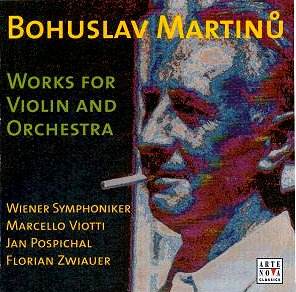Martinu knew the violin
from the inside and might in this capacity be compared with Sibelius
who at one stage aspired to a soloist's career. ů got as far as
the third desk in the second violins of Vaclav Talich's Czech
Philharmonic.
The Duo Concertant was written in Nice
and premiered in Lausanne by the work's dedicatees, Victor and Georges
Desarzens, the latter of whom was to become a conductor. Of three movements
the first is busy and just a little time-serving. The middle movement
is much stronger - a 7 and a 1/2 minute adagio rising to a frenetic
pitch and then subsiding. Bach and Beethoven are influences but Martinuů
delicately traces and entwines the solo instruments into what is very
satisfying meditation fading ppp. Quite a discovery! There
are moments when this sounds like the Holst or Malcolm Arnold Double
Concertos or Vaughan Williams' Concerto Accademico. Ths danger
is most present in the first movement as the finale is extremely inventive
and in this fairly close-up recording every detail registers with warmly
intimate proximity - perhaps a bit claustrophobic. The finale has a
lovely theme - try 3.34 of track 3. I am not aware of any competition
for this work; indeed this recording may be its premiere on disc.
The Violin Concerto No. 2 is better known or
at least less obscure. It has been recorded by Josef Suk on a CD with
the First Concerto and the Rhapsody Concerto
for viola (Supraphon 11 1969-02 011). The work was written for Mischa
Elman at his commission. This was one of the earliest patronages of
Martinu's dispossessed exile in the USA. The work was premiered in Boston
with Koussevitsky and his orchestra
on 23 December 1943. Elman had been drawn to Martinu on hearing the
premiere of the First Symphony - remember that all six symphonies were
written and premiered in the USA.
The contours of its themes are comparable with those
in the Fourth and Fifth Symphonies. Indeed it is by contrast with the
intermittently neo-classical Duo Concertant a
much more romantic work in which leaping, tumbling themes rush and slide,
scamper and serenade. Martinu's luminously lyrical side predominates.
The work will appeal to you if you like the symphonies. The mood
span is extensive and this is evidently the work of a man who appears
to have reached for a much more inclusive emotional palette. The work
sounds well in Pospichal's hands and his tone opens out in a way that
the Duo Concertant did not invite. There is some lovely work
in the andante moderato - just listen to the answering sigh of
the first violins in the opening dialogue with the winds. This Dvorak-inspired
heart's ease is done with a natural touch and no shading of insincerity
or hollow pastiche. This is a very good performance and the sound-picture
opens out with generosity in contrast to the shut-in effect of the Duo
Concertant. It lacks the searing edge of the historical performance
by Louis Kaufmann on Citadel but is a viable alternative to Josef Suk's
Supraphon version recorded in Prague with Vaclav Neumann and the Czech
Phil on 24-26 September 1973.
The Double Concerto was written for the Beal
Twins (Gerald and Wilfred) and premiered by them in Dallas on 8 January
1951. It has slight traces of the desiccation of the Duo Concertant
but majors in the neo-romantic affluent impressionism favoured for
the symphonies even if there is a Haydn-like tone to the middle movement.
The finale almost pitches into a foot-tapping rumba at one moment and
of all the three works this is the closest in idiom and in warmly inventive
writing to the masterly Fourth Symphony. Has the Double Concerto been
recorded before? I do not recall an alternative version.
This disc complements the Supraphon CD mentioned above
and is more than worth its bargain basement price.
The notes provide essential information. Recording
quality is much better than the first impressions left by the Duo
Concertant may suggest and Martinu's
antiphonal effects are lovingly portrayed ... and just listen
to the sun-warmed tracery at 4.43 and just before. The last three minutes
are joyous and exuberant.
Both violinists tend towards narrow scorching tone
and I must say that a fruitier bloom would have been welcome in the
Duo Concetant but all is redeemed by the other two works.
Do not miss this disc if you care at all for the lyrical-impressionist
strain in twentieth century music.
Rob Barnett


